Abstract expressionism in the United States emerged as a distinct art movement in the immediate aftermath of World War II and gained mainstream acceptance in the 1950s, a shift from the American social realism of the 1930s influenced by the Great Depression and Mexican muralists. The term was first applied to American art in 1946 by the art critic Robert Coates. Key figures in the New York School, which was the center of this movement, included such artists as Arshile Gorky, Jackson Pollock, Franz Kline, Mark Rothko, Norman Lewis, Willem de Kooning, Adolph Gottlieb, Clyfford Still, Robert Motherwell and Theodoros Stamos among others.
Action painting, sometimes called "gestural abstraction", is a style of painting in which paint is spontaneously dribbled, splashed or smeared onto the canvas, rather than being carefully applied. The resulting work often emphasizes the physical act of painting itself as an essential aspect of the finished work or concern of its artist.

Willem de Kooning was a Dutch-American abstract expressionist artist. Born in Rotterdam, in the Netherlands, he moved to the United States in 1926, becoming a US citizen in 1962. In 1943, he married painter Elaine Fried.

Lenore "Lee" Krasner was an American painter and visual artist active primarily in New York whose work has been associated with the Abstract Expressionist movement. She received her early academic training at the Women's Art School of Cooper Union, and the National Academy of Design from 1928 to 1932. Krasner's exposure to Post-Impressionism at the newly opened Museum of Modern Art in 1929 led to a sustained interest in modern art. In 1937, she enrolled in classes taught by Hans Hofmann, which led her to integrate influences of Cubism into her paintings. During the Great Depression, Krasner joined the Works Progress Administration's Federal Art Project, transitioning to war propaganda artworks during the War Services era.

Franz Kline was an American painter. He is associated with the Abstract Expressionist movement of the 1940s and 1950s. Kline, along with other action painters like Jackson Pollock, Willem de Kooning, Robert Motherwell, John Ferren, and Lee Krasner, as well as local poets, dancers, and musicians came to be known as the informal group, the New York School. Although he explored the same innovations to painting as the other artists in this group, Kline's work is distinct in itself and has been revered since the 1950s.

Elaine Marie Catherine de Kooning was an Abstract Expressionist and Figurative Expressionist painter in the post-World War II era. She wrote extensively on the art of the period and was an editorial associate for Art News magazine.
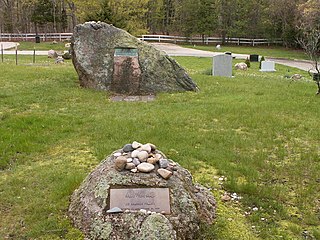
Green River Cemetery is a cemetery in the hamlet of Springs, New York within the Town of East Hampton.
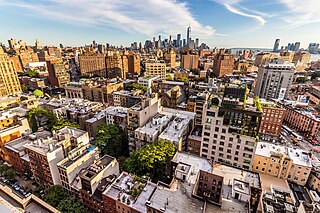
The 9th Street Art Exhibition of Paintings and Sculpture is the official title artist Franz Kline hand-lettered onto the poster he designed for the Ninth Street Show. Now considered historic, the artist-led exhibition marked the formal debut of Abstract Expressionism, and the first American art movement with international influence. The School of Paris, long the headquarters of the global art market, typically launched new movements, so there was both financial and cultural fall-out when all the excitement was suddenly emanating from New York. The postwar New York avant-garde, artists like Willem de Kooning and Jackson Pollock, would soon become "art stars," commanding large sums and international attention. The Ninth Street Show marked their "stepping-out," and that of nearly 75 other artists, including Harry Jackson, Helen Frankenthaler, Michael Goldberg, Joan Mitchell, Grace Hartigan, Robert De Niro Sr., John Ferren, Philip Guston, Elaine de Kooning, Lee Krasner, Franz Kline, Ad Reinhardt, David Smith, Milton Resnick, Joop Sanders, Robert Motherwell, Barnett Newman, and many others who were then mostly unknown to an art establishment that ignored experimental art without a ready market.

The Cedar Tavern was a bar and restaurant at the eastern edge of Greenwich Village, New York City. In its heyday, known as a gathering place for avant garde writers and artists, it was located at 24 University Place, near 8th Street. It was famous in its day as a hangout of many prominent Abstract Expressionist painters and Beat writers and poets. It closed in April 1963 and reopened three blocks north in 1964, at 82 University Place, between 11th and 12th Streets.
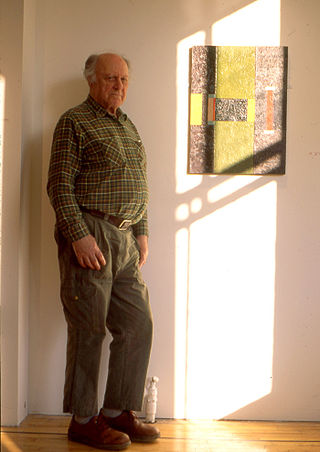
Roy Newell (1914-2006) was an American abstract painter.

New York Figurative Expressionism is a visual arts movement and a branch of American Figurative Expressionism. Though the movement dates to the 1930s, it was not formally classified as "figurative expressionism" until the term arose as a counter-distinction to the New York–based postwar movement known as Abstract Expressionism.

Joop Sanders was a Dutch-American painter, educator, and founding member of the American Abstract Expressionist group. He was the youngest member of the first generation of the New York School.

Mary Lee Abbott was an American artist, known as a member of the New York School of abstract expressionists in the late 1940s and 1950s. Her abstract and figurative work were also influenced by her time spent in Saint Croix and Haiti, where she lived off and on throughout the 1950s.
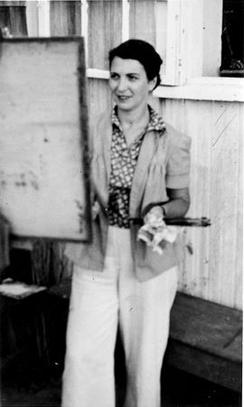
Perle Fine (1905–1988) was an American Abstract expressionist painter. Fine's work was most known by its combination of fluid and brushy rendering of the materials and the use of biomorphic forms encased and intertwined with irregular geometric shapes.
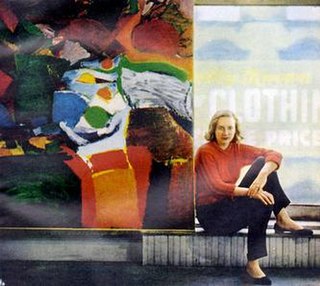
Grace Hartigan was an American Abstract Expressionist painter and a significant member of the vibrant New York School of the 1950s and 1960s. Her circle of friends, who frequently inspired one another in their artistic endeavors, included Jackson Pollock, Larry Rivers, Helen Frankenthaler, Willem and Elaine de Kooning and Frank O'Hara. Her paintings are held by numerous major institutions, including the Museum of Modern Art in New York City. As director of the Maryland Institute College of Art's Hoffberger School of Painting, she influenced numerous young artists.
Philip Pavia (1911-2005) was a culturally influential American artist of Italian descent, known for his scatter sculpture and figurative abstractions, and the debate he fostered among many of the 20th century's most important art thinkers. A founder of the New York School of Abstract Expressionism, he "did much to shift the epicenter of Modernism from Paris to New York," both as founding organizer of The Club and as founder, editor and publisher of the short-lived but influential art journal It Is: A Magazine for Abstract Art. Reference to the magazine appears in the archives of more than two dozen celebrated art figures, including Picasso, Peggy Guggenheim, and art critic Clement Greenberg. The Club is credited with inspiring art critic Harold Rosenberg’s influential essay “The American Action Painters" and the historic 9th Street Show.

Woman VI is a 1953 abstract work of art painted by Willem de Kooning and first displayed at the Sidney Janis Gallery in Manhattan. Since the 1955 Carnegie International Exhibition, Woman VI has been on view at the Carnegie Museum of Art as part of the Postwar Abstraction collection. The Woman paintings of the early 1950s are widely considered to be de Kooning’s most important works for their significance to postwar American cultural history and social events, such as the mid-century Feminist Movements. Many of the paintings are speculated to be abstracted portraits of Marilyn Monroe. Woman VI is notable within the series for its brighter palette of green and red paint employed in larger fields of color.
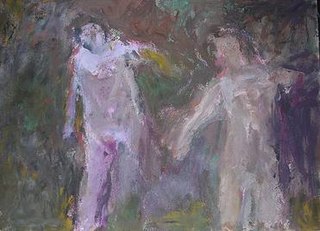
Milton Resnick was an American artist noted for abstract paintings that coupled scale with density of incident. It was not uncommon for some of the largest paintings to weigh in excess of three hundred pounds, almost all of it pigment. He had a long and varied career, lasting about sixty-five years. He produced at least eight hundred canvases and eight thousand works on paper and board.
The Club has been called "a schoolhouse of sorts ... as well as a theater, gallery space, and a dancehall...." Created by abstract expressionist sculptor Philip Pavia, The Club grew out of the informal gatherings among dozens of painters and sculptors who all had art studios in Lower Manhattan between 8th and 12th streets and First and Sixth Avenues during the late 1940s and early 1950s. Membership included many of New York's most important mid-century artists and thinkers, predominantly painters and sculptors like Willem de Kooning, Franz Kline, Isamu Noguchi, John Ferren, and Robert Motherwell, as well as nearly all the artists later called the New York School. But other celebrated artists, cultural figures and major 20th-century thinkers attended meetings, including philosopher Joseph Campbell, composer John Cage and political theorist Hannah Arendt. Structured to facilitate the growth and dissemination of ideas about art by artists for artists, especially abstract expressionist art, The Club lent New York's art scene the vitality and international influence Paris had long monopolized, and U.S. artists had long craved.

Colin Adriel Goldberg is an American visual artist known for his role in the development of Techspressionism.
















